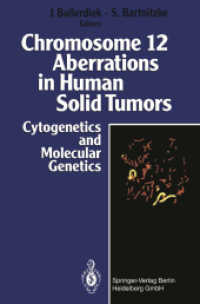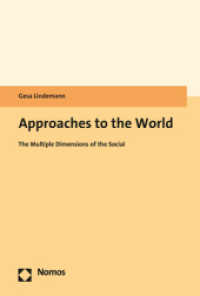- ホーム
- > 洋書
- > 英文書
- > Science / Mathematics
Full Description
This book will describe recent theoretical advances of cold atom physics in optical lattices, concentrating on strongly correlated systems and possible applications in quantum information processing. Furthermore, the latest experiments aiming towards realizing these theoretical ideas will be discussed. The book will present in detail recently developed quantum optical tools for manipulating atoms in optical lattices and show how they can be used to realize a large range of well controlled many body Hamiltonians. Connections and differences to standard condensed matter physics will be explained. Finally, it will discuss how the ability to dynamically change parameters in these Hamiltonians on time scales much shorter than typical decoherence times can be exploited to realize quantum information processing devices with neutral atoms in optical lattices.
Contents
1 IntroductionPart I Few Atom Physics2 Optical potentials2.2 Periodic Lattice Structures2.3 Lattice engineering3 Single Atom Dynamics3.1 Intraband Dynamics3.2 Interband Dynamics3.3 Additional Trap Potential4 Atom atom interactions in optical lattices4.1 Interatomic Potentials4.2 s-wave Scattering4.3 Feshbach Resonances4.4 Losses5 Bose-Einstein Condensates in Optical Lattices5.1 The Gross-Pitaevskii Equation5.2 Double Well Potential5.3 Translationally Invariant Lattices5.4 Harmonically Trapped LatticesPart II Many Atom Physics6 Hubbard Models in Optical Lattices6.1 Derivation of the Bose-Hubbard Model6.2 Superfluid to Mott Insulator transition6.3 Gutzwiller Ansatz6.4 Phase diagram6.5 Tonks-Girardeau Limit6.6 Multi component Hubbard model7 Loading of Degenerate Atomic Gases Into Optical Lattices7.1 Adiabatic Switching on a Lattice7.2 Defect suppressed lattices7.3 Irreversible Loading and Cooling Schemes8 Condensed matter models8.1 Spin Models in Multicomponent Systems8.2 Effective magnetic fields8.3 Atomic Quantum Dots8.4 Lattice Immersions8.5 Unitary Dynamics and Numerical Methods8.6 Detection Methods9 Quantum information processing in optical lattices9.1 diVincenzo Criteria in Optical Lattices9.2 Entanglement Engineering9.3 Graph States and One Way Computing9.4 Quantum Random Walks10 Summary and outlook






